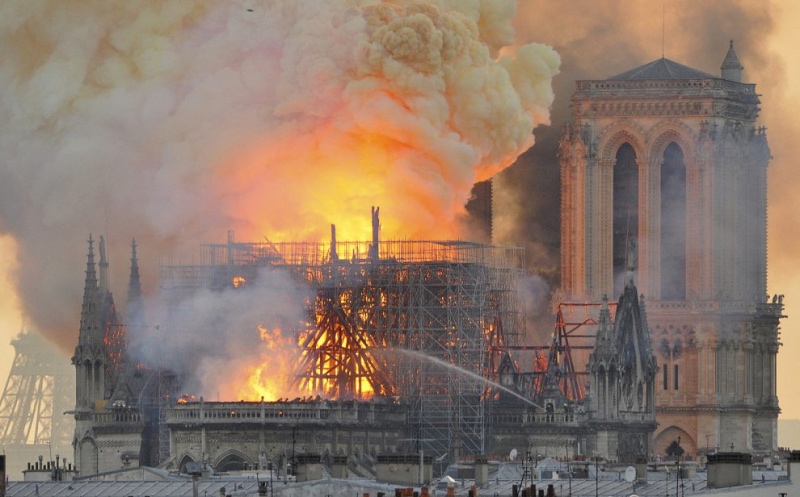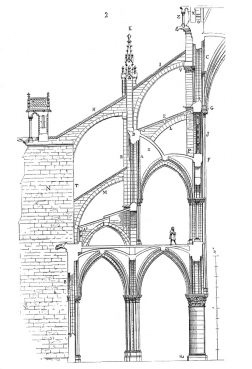
US-based Gothic architecture scholar MAILE HUTTERER, in an article first published on The Conversation, looks at the tumultuous history of Notre Dame Cathedral in Paris…
The Notre-Dame de Paris had been damaged and changed many times since it was begun in the mid-12th century. But the fire on 15th April might have been its most catastrophic event.
Located on the eastern end of the Ile-de-la-Cité, an island on the Seine River, the site was a Christian church since the fourth century. And for a long time, it remained a powerful symbol of church authority. Even today, it is the seat of the archbishop of Paris.

Flames and smoke rise from the blaze after the spire toppled on Notre Dame Cathedral in Paris, on 15th April, 2019. An inferno that raged through Notre Dame Cathedral for more than 12 hours destroyed its spire and its roof but spared its twin medieval bell towers, and a frantic rescue effort saved the monument’s “most precious treasures,” including the crown of thorns purportedly worn by Jesus, officials said. PICTURE: AP Photo/Thierry Mallet.
“The current cathedral, dedicated to Our Lady, or the Virgin Mary, replaced an earlier cathedral that was built during the Merovingian period which lasted from the fifth to eighth century. The earlier building was dedicated to Saint Stephen, the first Christian martyr.”
As a scholar of Gothic architecture I have studied how this and other buildings were continuously adapted to reflect changing architectural fashion and to enhance the spiritual experience of the visitor.
Key part of religious district
The current cathedral, dedicated to Our Lady, or the Virgin Mary, replaced an earlier cathedral that was built during the Merovingian period which lasted from the fifth to eighth century. The earlier building was dedicated to Saint Stephen, the first Christian martyr.
Maurice de Sully is believed to have initiated the rebuilding of the cathedral around the same time that he became bishop of Paris in 1160. Maurice had previously served as archdeacon of the cathedral where he also taught theology.
Other church officials likely also had a role in this rebuilding as the cathedral canons, or clerics, and not the bishop held authority over the structure.
Reconstruction of the cathedral was part of a larger redesign of the eastern part of the Ile-de-la-Cité. This neighbourhood housed the church officials, masters, clerics, servants and others who worked to run the diocese of Paris and the cathedral school.
Maurice’s other projects at the time included construction of a new street, the rue Neuve Notre-Dame, which ran from the cathedral to the west – now replaced by the square in front of the cathedral. He also built a new palace for the bishop and a new charitable hospital.
How structures were added
Construction proceeded under a series of master builders.
The first part of the cathedral to be built was the eastern part, or choir. This was to serve as the religious heart of the structure where the main altar would be located. Construction then generally proceeded westward, though multiple parts of the building were sometimes worked on simultaneously.
The design, however, was continuously revised during the course of construction. For example, in the 1220s the upper wall of the cathedral, which had already been constructed, was demolished and rebuilt to allow for larger windows. This transformed the building from a four-story to a three-story structure.
The new cathedral was largely completed by around 1245, although, construction continued in various parts until the mid-14th century. During these 200 years chapels were added along the exterior of the cathedral, some structural supports modified and the transept arms were extended, giving the cathedral a cross-like shape.
In my assessment, these many remodels during the Middle Ages demonstrated the vitality of the cathedral in medieval life and the creativity of the builders, as they adapted the building to changing architectural fashions and social practices. The change to a three-story structure, that had become the standard by the early 13th century, is one such example.
My forthcoming book shows how cathedrals, including Notre Dame of Paris, were connected to the daily life in the city. There were markets around cathedrals and also spaces where disputes could be resolved. In other words, the cathedral was an important part of medieval city life.
Meaning for France
Notre Dame was the most colossal church of its generation – wider and taller than other European churches of the mid-12th century.
There were several technological breakthroughs made in its construction. For example, it was a site of early experimentation with flying buttresses, the externalised buttressing arches that transfer the weight of the heavy stone vault away from the walls, which can then be pierced by large window openings filled with stained glass.
It was the first French Gothic cathedral to receive a line of chapels along its exterior. These were added to the building between the projecting buttress piers after 1228. Many other cathedrals would later adopt this pattern.
The chapels appended to the choir on the eastern end of the cathedral were the only ones from 1300-1350 to survive the French Revolution.

Cross-section of Notre Dame Cathedral’s double supporting arches and buttresses of the nave, drawn by Eugène Viollet-le-Duc as they would have appeared from 1220 to 1230. PICTURE: Courtesy of Creative Commons
Later restorations
Paris Cathedral played an important role in religious and secular life.
As the seat of the bishop, Notre Dame was the most significant religious building in the city. Its size and luxury symbolised the power of the church and the authority of the bishop. It was also the site of ceremonies connected to the King of France, including royal funerary processions and the royal entry, a ceremony in which the city received a new king.
Consequently, it was one of the many churches that were attacked during the French Revolution in the 1790s. This violence resulted in significant losses of medieval sculpture and stained glass and damage to the building itself.
By the 19th century, the cathedral was in a state of disrepair.
A major restoration effort began in 1843 under the supervision of architects Jean-Baptiste-Antoine Lassus and Eugène-Emmanuel Viollet-le-Duc, which was spurred by a larger renewal of interest in Gothic architecture. Viollet-le-Duc completed the restoration work in 1864.
Many of the building’s iconic features date to the 19th-century restorations. These include the crossing spire that collapsed in the recent fire. It also includes the many gargoyles and chimeras that peer out from the upper parts of the cathedral, many of which are modern replacements of medieval sculptures.
The 19th century also saw the construction of the parvis, or square in front of the cathedral, which significantly altered how one encounters the structure. Visitors to the cathedral now have a much larger area from which to view the front of the building which facilitates spectacular views of the cathedral’s twin towers.
Why it will survive
The roof of the cathedral was largely destroyed in the recent fire. While much of the building is constructed from stone, the roof was supported by enormous wooden beams that sat above the vault or curved stone ceiling of the church.
Details are still emerging about its priceless 13th-century stained glass windows. And it is too early to say how much of the art work housed in it survived.
The cathedral has stood for 800 years and withstood damage on many previous occasions. I am confident that it will survive this fire as well.
Although the 2019 fire may appear to many as a cataclysmic destruction, the cathedral is exceptionally well documented. Andrew Tallon, a scholar at Vassar College, who died last year, had digitally scanned the building, resulting in measurements of the structure that are more precise than any data previously gathered.
While some parts of the cathedral might be irreplaceable, I believe many future generations continue to admire and learn from this magnificent building, as well as its rich history.![]()
Maile Hutterer is assistant professor of the history of art and architecture at the University of Oregon. This article is republished from The Conversation under a Creative Commons license. Read the original article.





